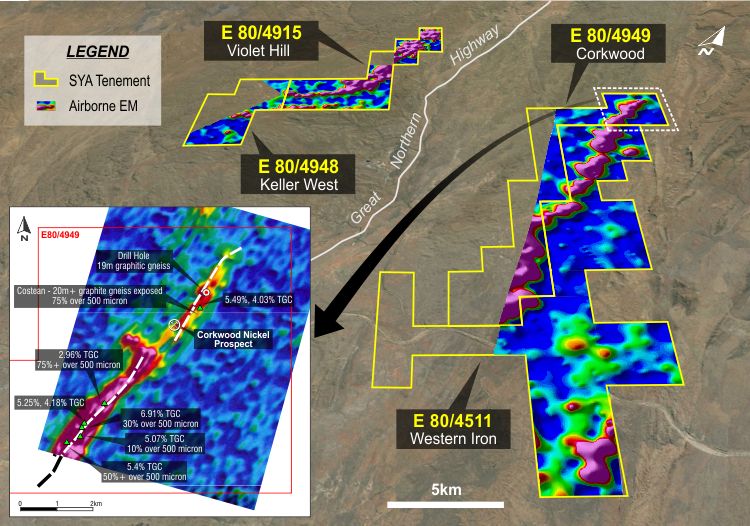Highlights:
– Petrological study of RC drill chips identifies large to jumbo flake graphite at Snowbird, Firefly and Windrush prospects
– Floatation test work on surface samples returns encouraging results with a best result of 96.2% TGC in flotation concentrate, with 43% in the plus 180 micron flake size
– Diamond core required to advance additional flake size characterization and floatation testing
Petrological Study
A petrological study of chips from the RC drilling program at the Snowbird, Windrush and Firefly prospect areas has demonstrated the large flake graphite potential of the project:
– Snowbird – SKRC016 (37-38m), flake size commonly between 300-400+ microns in length, with instances of flakes over 1000 micron;
– Windrush – SKRC007, flake size up to 500 microns and an averaging 200 microns in length; and
– Firefly – SKRC005 demonstrated that ~20% of the graphite flakes were between 350 and 400 microns in length, with an average 225 microns in length.
The RC drilling method has resulted in many of the graphite flakes being broken into smaller pieces. Diamond core samples will be required to finalise the actual flake size distribution.
The results give encouragement that the project has the potential to host high-value coarse flake graphite.
Flotation Testing
The Company has also completed flotation test work on both surface and RC chip samples. The best flotation results were achieved in surface rocks from the Snowbird prospect, where a floatation concentrate grade of 96.2% TGC was achieved, with 43% of the concentrate containing flakes above 180 mesh size. The metallurgical results provide encouragement that the Corkwood coarse flake graphite can deliver a high purity graphite concentrate using simple flotation technology.
Floatation testing of two RC drill chips samples were not successful, most likely due to oil contamination of sample during the RC drilling process.
Next Steps
Results provide encouragement that Corkwood can deliver high quality concentrate with large flake size. Diamond core is required to advance the flake size characterisation and floatation testing. Planning of an appropriate programme has commenced.
A study is also underway to identify higher grade zones to the mineralisation. Only one drilling program of 33 reverse circulation drill holes (for 2,949 metres) has been completed, focussed at six prospect areas, along portions of a 7 km strike extent. The drilling has identified higher grade zones, including an individual metre assay up to 12.2% TGC and a best intersection of 16m @ 5.03% TGC from 13m in SKRC006 at Windrush.
An approximate 20km strike extent to the target horizon displays coincident VTEM anomalism and remains largely untested by drilling. This large target has the potential to host additional high grade zones. Drilling in these new areas will be subject to heritage surveying and the Company reaching a satisfactory commercial arrangement with the Kimberley Land Council for access.
To view tables and figures, please visit this link.
Read the press release here.
Timeline
Sayona Mining Ltd Corkwood drilling – Broad zones of graphite mineralisation
Sayona Mining Ltd Quarterly Activities Report
Sayona Mining Ltd Robust Anomalies Defined in the Corkwood Geophysical Survey
